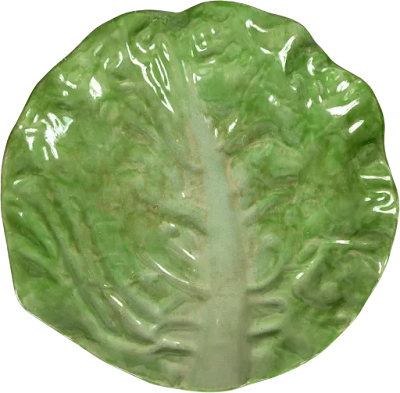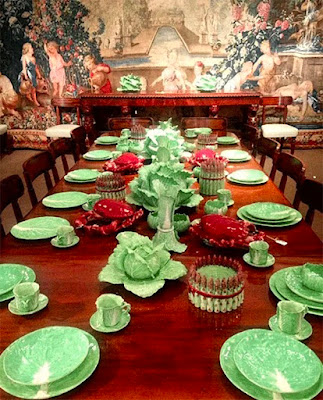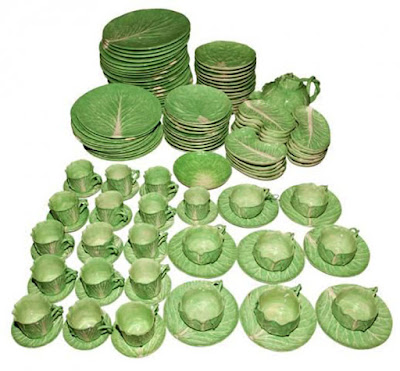For many years I was not a big fan of Wannopee Lettuce Leaf majolica.
The monochromatic color and seemingly formless shapes just bored me.
That all changed when I saw a large group of it in a collector's home. He had a large pine sideboard completely filled with nothing but Lettuce Leaf. It took my breath away! The variety of forms, shapes and sizes in this beautiful pale chartreuse color made for an amazing, cheery display.
Shortly thereafter Sotheby's auctioned off a collection of Wannopee Lettuce Leaf from the collection of Jackie Onnasis. The group of 20 pieces brought the phenomenal price of $6,900 and put Wannoppee Lettuce Leaf in the spotlight.
I have since learned to appreciate this odd form of American majolica.
Wannopee Lettuce Leaf was a trade name of the New Milford Pottery of Connecticut. The company made a wide range of ware beginning in September of 1887 but did not begin the production of majolica until 1901, long after most American majolica manufacturers had ceased making the ware.
This rather late addition to the American majolica cannon was unusual in other ways as well. The body is not the same sort of porous buff colored earthenware used by other majolica manufacturers. It is actually a hard white translucent body closer to porcelain in character than earthenware though it is still porous enough to stain. The coloring agent was applied to the piece after firing making it especially sensitive to wear. Most majolica is fired using colored glazes that bond with the lead undercoating making them impervious to wear or fading. Conventional pottery cleaning methods can completely remove the color from Lettuce Leaf, something that would never happen with conventional majolica.
I have since learned to appreciate this odd form of American majolica.
Wannopee Lettuce Leaf was a trade name of the New Milford Pottery of Connecticut. The company made a wide range of ware beginning in September of 1887 but did not begin the production of majolica until 1901, long after most American majolica manufacturers had ceased making the ware.
This rather late addition to the American majolica cannon was unusual in other ways as well. The body is not the same sort of porous buff colored earthenware used by other majolica manufacturers. It is actually a hard white translucent body closer to porcelain in character than earthenware though it is still porous enough to stain. The coloring agent was applied to the piece after firing making it especially sensitive to wear. Most majolica is fired using colored glazes that bond with the lead undercoating making them impervious to wear or fading. Conventional pottery cleaning methods can completely remove the color from Lettuce Leaf, something that would never happen with conventional majolica.
There are 25 recorded shapes in Lettuce Leaf. A complete set sold retail for $5.00 in 1903, the equivalent of about $115 in 2015 dollars. Perhaps it was too expensive for the times, but whatever the reason it remained in production for only two years at New Milford Pottery before the company ceased production in 1903. The molds were sold to employee Charles Reynolds who worked for the company as a decorator and designer.
Reynolds resumed production on Lettuce Leaf for a short time afterwards in association with the George H. Bowman Company of Cleveland, Ohio, before financial difficulties caused him to cease work on the pattern. The later Lettuce Leaf pieces look slightly different from the older ones with more even coloring of the surface and a slightly heavier body.
Considering the short time it was in production, Lettuce Leaf can still be purchased quite reasonably. Plates and small hollowware pieces are easily found under $50. It is really only the large hollowware pieces like the teapot that will cost serious money.
Other pieces that are hard to find include butter pats and large pitchers.
The color on pieces will vary from a pale chartreuse to a deep leafy green to a pale pink. Aside from wear, be sure to check the rims for chips or other damage. While chips on majolica are common, the extremely thinness of the rims on Lettuce Leaf make it particularly susceptible to damage.
 |
| Badly worn Lettuce Leaf with little color left |
Wannopee was certainly not the first pottery to use the lettuce leaf form for the design for a plate. The idea goes back at least as far as the 17th century. Mafra of Portugal created their own form of cabbage leaf majolica ware in the 1800's.
The cabbage leaves of Naples Studio, E.B. are believed to be the model on which Lettuce Leaf was built. On this foundation Wannopee brought the idea to America.
 |
| MIS image showing the cabbage ware of Mafra |
The cabbage leaves of Naples Studio, E.B. are believed to be the model on which Lettuce Leaf was built. On this foundation Wannopee brought the idea to America.
 |
| The leaves of E.B. Napoli |
This lowly pottery has inspired a host of imitators. Most notable of these is the Palm Beach potter Dodie Thayer, who began making her own version of Lettuce Leaf by hand in the 1960's which she called Lettuce Ware.
 |
| Dodie Thayer's Lettuce Ware Dodie Thayer's Lettuce Ware |
Of all the Twentieth Century reproductions of majolica attempted, this was certainly the most successful. Soon it became the preppy go-to pottery of the Palm Beach social set with heiresses like Brooke Astor, the Duchess of Windsor and C.Z. Guest assembling large collections of Dodie Thayer Lettuce Ware pottery for their afternoon teas.
C.Z. Guest’s collection of Thayer’s Lettuce Ware
Thayer ceased making her Lettuce Ware in the 1980's but it has remained highly sought after by collectors; so much so that another company, Tory Burch, has started to reissue the line to great success.
Tory Burch’s Lettuce Ware line
As well made as these are however they don't even begin to match the delicacy of the Wannopee majolica original. Mrs. Onnasis certainly had an eye for quality!
So the next time you see a piece of Lettuce Leaf at a flea market, pick it up. It will add variety and a unique bit of history to your collection.




















Where did you find the Lettuce Leaf pitcher picture? Would you like to buy one? (Pitcher, not picture, that is. =)
ReplyDeleteI'm just starting to sell off my, er, inheritance:
zinizu.blogspot.com
Sorry, folks. New Milford Pottery Co. & Wannopee Pottery were in production from 1887 until 1903 In New Milford, CONNECTICUT. Not New Hampshire. BTW Wannopee has only one P. Dick in New Milford, CT.
DeleteHappy to make the correction. Thanks!
DeleteMy grandmother's family lived in Old Greenwich. Looking through the attic, I just found a Wannopee piece. It is a relish, I guess, in the shape of a larger Romaine lettuce leaf and it's in perfect condition! It was so much fun trying to track down the origin of the piece!
ReplyDelete